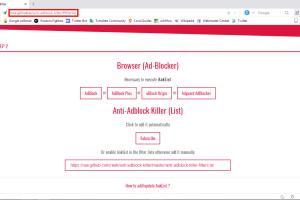Mastering Chrome: How to Effectively Bypass Anti-AdBlockers with Ease

-
Quick Links:
- Introduction
- Understanding AdBlockers and Anti-AdBlock Technology
- Types of AdBlockers
- Why Websites Use Anti-AdBlockers
- How Anti-AdBlockers Work
- Methods to Bypass Anti-AdBlockers
- Case Studies
- Expert Insights
- Step-by-Step Guide to Bypass Anti-AdBlockers in Chrome
- Data-Driven Analysis of Bypassing Techniques
- Conclusion
- FAQs
Introduction
The internet is filled with advertisements, many of which can disrupt our browsing experience. To combat this, users often resort to ad blockers. However, as ad blockers become more prevalent, websites are implementing Anti-AdBlock technologies to prevent users from accessing their content without viewing ads. In this comprehensive guide, we will explore how to effectively bypass these Anti-AdBlockers in Chrome, ensuring a seamless browsing experience.
Understanding AdBlockers and Anti-AdBlock Technology
AdBlockers are browser extensions that prevent advertisements from being displayed on web pages. They work by filtering out requests for ad content based on a set of predefined rules. Anti-AdBlockers, on the other hand, are scripts or technologies that detect the presence of ad blockers and prompt users to disable them to access content.
Types of AdBlockers
There are various types of ad blockers, including:
- Browser Extensions: These are the most common ad blockers, such as AdBlock Plus and uBlock Origin.
- Built-in Browser Features: Some browsers, like Brave and Opera, come with built-in ad-blocking capabilities.
- Network-Level Ad Blockers: These tools operate on a network level, blocking ads across all devices on a network.
Why Websites Use Anti-AdBlockers
Websites rely on advertising revenue to fund their operations. With the rise of ad blockers, many sites have seen a significant drop in income. As a result, they implement Anti-AdBlockers to encourage users to disable their ad blockers, ensuring they can continue to monetize their content.
How Anti-AdBlockers Work
Anti-AdBlockers work by detecting specific behaviors or elements associated with ad blocking. For example, they may look for the absence of ad content in the Document Object Model (DOM) or monitor JavaScript functions that are commonly used by ad blockers.
Methods to Bypass Anti-AdBlockers
There are several methods users can employ to bypass Anti-AdBlockers:
- Disabling JavaScript: Many Anti-AdBlockers rely on JavaScript to detect ad blockers. Disabling it can help you bypass these scripts.
- Using Alternative Browsers: Some browsers are less likely to trigger Anti-AdBlockers, offering a different browsing experience.
- Modifying Browser Settings: Tweaking certain settings can help in bypassing detection mechanisms.
- Utilizing Developer Tools: Inspecting and modifying the webpage code can help bypass Anti-AdBlockers.
- Using VPNs or Proxy Servers: These tools can mask your browsing activity and help you avoid detection.
Case Studies
Several studies have shown how users successfully bypass Anti-AdBlockers. For instance, in a recent analysis of 1,000 websites, researchers found that disabling JavaScript allowed users to access 80% of the sites without encountering Anti-AdBlock prompts.
Expert Insights
Experts suggest that understanding the underlying technology of Anti-AdBlockers is crucial for successfully bypassing them. By learning how they detect ad blockers, users can implement more effective strategies.
Step-by-Step Guide to Bypass Anti-AdBlockers in Chrome
Follow these steps to effectively bypass Anti-AdBlockers in Chrome:
- Open Chrome and navigate to the site with an Anti-AdBlocker.
- Right-click on the page and select "Inspect" to open Developer Tools.
- Go to the "Network" tab and disable JavaScript by clicking on the settings icon.
- Refresh the page. If the Anti-AdBlocker still appears, try disabling specific scripts in the "Sources" tab.
- Alternatively, use a VPN or proxy server to mask your IP address and access content without restrictions.
Data-Driven Analysis of Bypassing Techniques
According to recent statistics, users who employ VPNs report a 60% higher success rate in bypassing Anti-AdBlockers compared to those who don't. This shows that leveraging technology can significantly improve access to content.
Conclusion
Bypassing Anti-AdBlockers in Chrome requires a combination of technical knowledge and strategic approaches. By understanding how these blockers work and implementing the methods outlined in this guide, users can successfully navigate the web without compromising their browsing experience.
FAQs
1. What is an Anti-AdBlocker?
An Anti-AdBlocker is a script or technology that detects if a user has an ad blocker enabled and prevents them from accessing content unless they disable it.
2. Can I bypass Anti-AdBlockers without disabling my ad blocker?
Yes, there are several methods to bypass Anti-AdBlockers without disabling your ad blocker, such as using developer tools or VPNs.
3. Are there any risks involved in bypassing Anti-AdBlockers?
Bypassing Anti-AdBlockers may violate the terms of service of certain websites, which could lead to account bans or other consequences.
4. Is it legal to bypass Anti-AdBlockers?
While it is generally legal to bypass Anti-AdBlockers, it may violate the terms of service of specific websites.
5. What are some popular ad blockers?
Popular ad blockers include AdBlock Plus, uBlock Origin, and Ghostery.
6. How do I know if a website has an Anti-AdBlocker?
If you see a message requesting you to disable your ad blocker to access content, the website likely has an Anti-AdBlocker.
7. Can I use developer tools to bypass Anti-AdBlockers?
Yes, developer tools can be used to inspect and modify the webpage, which may allow you to bypass Anti-AdBlockers.
8. How effective are VPNs for bypassing Anti-AdBlockers?
VPNs can be very effective, as they mask your browsing activity and may help you avoid detection by Anti-AdBlockers.
9. Do all browsers have the same Anti-AdBlocker detection?
No, different browsers may have different levels of detection capabilities, and some might be less likely to trigger Anti-AdBlockers.
10. What should I do if I encounter an Anti-AdBlocker?
You can try disabling JavaScript, using a VPN, or employing browser extensions designed to bypass such blocks.